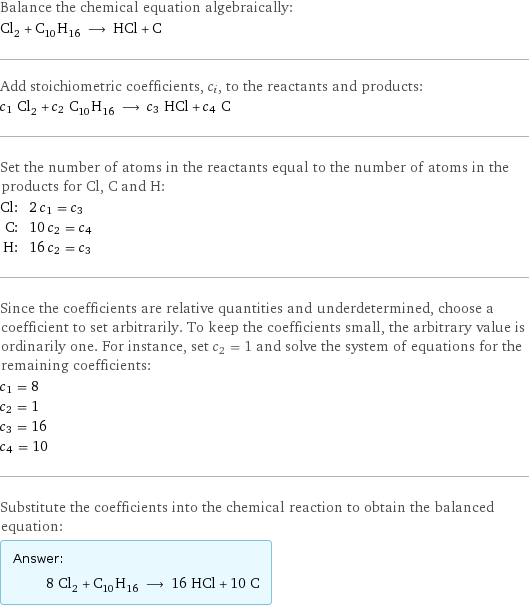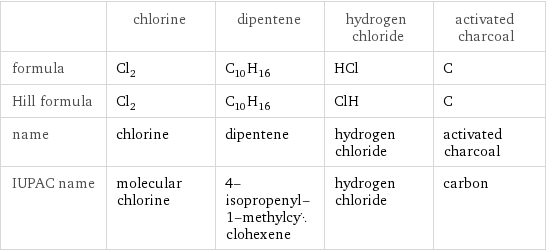Input interpretation

Cl_2 chlorine + C_10H_16 dipentene ⟶ HCl hydrogen chloride + C activated charcoal
Balanced equation

Balance the chemical equation algebraically: Cl_2 + C_10H_16 ⟶ HCl + C Add stoichiometric coefficients, c_i, to the reactants and products: c_1 Cl_2 + c_2 C_10H_16 ⟶ c_3 HCl + c_4 C Set the number of atoms in the reactants equal to the number of atoms in the products for Cl, C and H: Cl: | 2 c_1 = c_3 C: | 10 c_2 = c_4 H: | 16 c_2 = c_3 Since the coefficients are relative quantities and underdetermined, choose a coefficient to set arbitrarily. To keep the coefficients small, the arbitrary value is ordinarily one. For instance, set c_2 = 1 and solve the system of equations for the remaining coefficients: c_1 = 8 c_2 = 1 c_3 = 16 c_4 = 10 Substitute the coefficients into the chemical reaction to obtain the balanced equation: Answer: | | 8 Cl_2 + C_10H_16 ⟶ 16 HCl + 10 C
Structures

+ ⟶ +
Names

chlorine + dipentene ⟶ hydrogen chloride + activated charcoal
Equilibrium constant
![Construct the equilibrium constant, K, expression for: Cl_2 + C_10H_16 ⟶ HCl + C Plan: • Balance the chemical equation. • Determine the stoichiometric numbers. • Assemble the activity expression for each chemical species. • Use the activity expressions to build the equilibrium constant expression. Write the balanced chemical equation: 8 Cl_2 + C_10H_16 ⟶ 16 HCl + 10 C Assign stoichiometric numbers, ν_i, using the stoichiometric coefficients, c_i, from the balanced chemical equation in the following manner: ν_i = -c_i for reactants and ν_i = c_i for products: chemical species | c_i | ν_i Cl_2 | 8 | -8 C_10H_16 | 1 | -1 HCl | 16 | 16 C | 10 | 10 Assemble the activity expressions accounting for the state of matter and ν_i: chemical species | c_i | ν_i | activity expression Cl_2 | 8 | -8 | ([Cl2])^(-8) C_10H_16 | 1 | -1 | ([C10H16])^(-1) HCl | 16 | 16 | ([HCl])^16 C | 10 | 10 | ([C])^10 The equilibrium constant symbol in the concentration basis is: K_c Mulitply the activity expressions to arrive at the K_c expression: Answer: | | K_c = ([Cl2])^(-8) ([C10H16])^(-1) ([HCl])^16 ([C])^10 = (([HCl])^16 ([C])^10)/(([Cl2])^8 [C10H16])](../image_source/246cfc3981abbd050f94817247a272a5.png)
Construct the equilibrium constant, K, expression for: Cl_2 + C_10H_16 ⟶ HCl + C Plan: • Balance the chemical equation. • Determine the stoichiometric numbers. • Assemble the activity expression for each chemical species. • Use the activity expressions to build the equilibrium constant expression. Write the balanced chemical equation: 8 Cl_2 + C_10H_16 ⟶ 16 HCl + 10 C Assign stoichiometric numbers, ν_i, using the stoichiometric coefficients, c_i, from the balanced chemical equation in the following manner: ν_i = -c_i for reactants and ν_i = c_i for products: chemical species | c_i | ν_i Cl_2 | 8 | -8 C_10H_16 | 1 | -1 HCl | 16 | 16 C | 10 | 10 Assemble the activity expressions accounting for the state of matter and ν_i: chemical species | c_i | ν_i | activity expression Cl_2 | 8 | -8 | ([Cl2])^(-8) C_10H_16 | 1 | -1 | ([C10H16])^(-1) HCl | 16 | 16 | ([HCl])^16 C | 10 | 10 | ([C])^10 The equilibrium constant symbol in the concentration basis is: K_c Mulitply the activity expressions to arrive at the K_c expression: Answer: | | K_c = ([Cl2])^(-8) ([C10H16])^(-1) ([HCl])^16 ([C])^10 = (([HCl])^16 ([C])^10)/(([Cl2])^8 [C10H16])
Rate of reaction
![Construct the rate of reaction expression for: Cl_2 + C_10H_16 ⟶ HCl + C Plan: • Balance the chemical equation. • Determine the stoichiometric numbers. • Assemble the rate term for each chemical species. • Write the rate of reaction expression. Write the balanced chemical equation: 8 Cl_2 + C_10H_16 ⟶ 16 HCl + 10 C Assign stoichiometric numbers, ν_i, using the stoichiometric coefficients, c_i, from the balanced chemical equation in the following manner: ν_i = -c_i for reactants and ν_i = c_i for products: chemical species | c_i | ν_i Cl_2 | 8 | -8 C_10H_16 | 1 | -1 HCl | 16 | 16 C | 10 | 10 The rate term for each chemical species, B_i, is 1/ν_i(Δ[B_i])/(Δt) where [B_i] is the amount concentration and t is time: chemical species | c_i | ν_i | rate term Cl_2 | 8 | -8 | -1/8 (Δ[Cl2])/(Δt) C_10H_16 | 1 | -1 | -(Δ[C10H16])/(Δt) HCl | 16 | 16 | 1/16 (Δ[HCl])/(Δt) C | 10 | 10 | 1/10 (Δ[C])/(Δt) (for infinitesimal rate of change, replace Δ with d) Set the rate terms equal to each other to arrive at the rate expression: Answer: | | rate = -1/8 (Δ[Cl2])/(Δt) = -(Δ[C10H16])/(Δt) = 1/16 (Δ[HCl])/(Δt) = 1/10 (Δ[C])/(Δt) (assuming constant volume and no accumulation of intermediates or side products)](../image_source/7c5143180d23fd8ddccbeb57e1c84fca.png)
Construct the rate of reaction expression for: Cl_2 + C_10H_16 ⟶ HCl + C Plan: • Balance the chemical equation. • Determine the stoichiometric numbers. • Assemble the rate term for each chemical species. • Write the rate of reaction expression. Write the balanced chemical equation: 8 Cl_2 + C_10H_16 ⟶ 16 HCl + 10 C Assign stoichiometric numbers, ν_i, using the stoichiometric coefficients, c_i, from the balanced chemical equation in the following manner: ν_i = -c_i for reactants and ν_i = c_i for products: chemical species | c_i | ν_i Cl_2 | 8 | -8 C_10H_16 | 1 | -1 HCl | 16 | 16 C | 10 | 10 The rate term for each chemical species, B_i, is 1/ν_i(Δ[B_i])/(Δt) where [B_i] is the amount concentration and t is time: chemical species | c_i | ν_i | rate term Cl_2 | 8 | -8 | -1/8 (Δ[Cl2])/(Δt) C_10H_16 | 1 | -1 | -(Δ[C10H16])/(Δt) HCl | 16 | 16 | 1/16 (Δ[HCl])/(Δt) C | 10 | 10 | 1/10 (Δ[C])/(Δt) (for infinitesimal rate of change, replace Δ with d) Set the rate terms equal to each other to arrive at the rate expression: Answer: | | rate = -1/8 (Δ[Cl2])/(Δt) = -(Δ[C10H16])/(Δt) = 1/16 (Δ[HCl])/(Δt) = 1/10 (Δ[C])/(Δt) (assuming constant volume and no accumulation of intermediates or side products)
Chemical names and formulas

| chlorine | dipentene | hydrogen chloride | activated charcoal formula | Cl_2 | C_10H_16 | HCl | C Hill formula | Cl_2 | C_10H_16 | ClH | C name | chlorine | dipentene | hydrogen chloride | activated charcoal IUPAC name | molecular chlorine | 4-isopropenyl-1-methylcyclohexene | hydrogen chloride | carbon
Substance properties

| chlorine | dipentene | hydrogen chloride | activated charcoal molar mass | 70.9 g/mol | 136.24 g/mol | 36.46 g/mol | 12.011 g/mol phase | gas (at STP) | liquid (at STP) | gas (at STP) | solid (at STP) melting point | -101 °C | -89 °C | -114.17 °C | 3550 °C boiling point | -34 °C | 175 °C | -85 °C | 4027 °C density | 0.003214 g/cm^3 (at 0 °C) | 0.86 g/cm^3 | 0.00149 g/cm^3 (at 25 °C) | 2.26 g/cm^3 solubility in water | | insoluble | miscible | insoluble surface tension | | 0.026 N/m | |
Units
